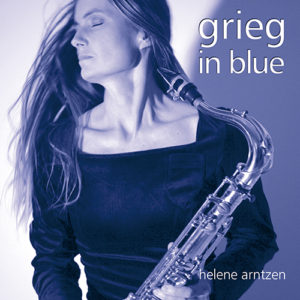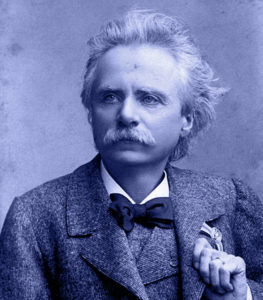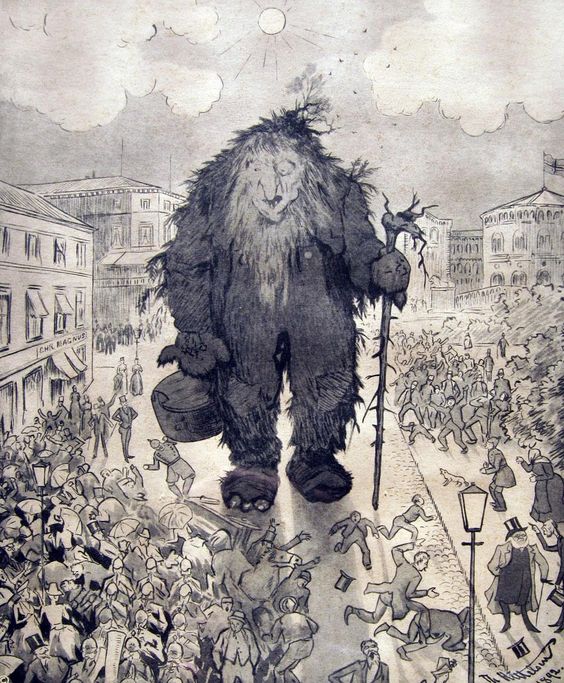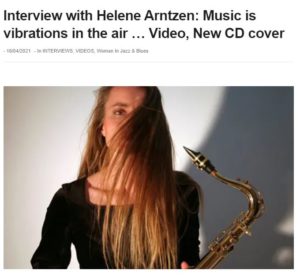 Grieg in Blue
Grieg in Blue
Helene Arntzen
Sortie digitale
Œuvres de Edvard Grieg revisitées en mode Jazz
Arrangements : Helene Arntzen et Franck Monbaylet
Helene Arntzen – saxophones
Franck Monbaylet – piano
Claude Mouton – contrebasse
Pascal Rey – percussion
#TAC034
Editions Stella Polaris
Un voyage à travers le jazz pour redécouvrir la musique d’Edvard Grieg
La musique du compositeur Norvégien Edvard Grieg appartient au patrimoine musical de référence mondial.
En compagnie de ses musiciens, la saxophoniste norvégienne Helene Arntzen, rend hommage à l’œuvre de ce compositeur et mélodiste exceptionnel.
Les compositions d’Edvard Grieg, deviennent une évidence au contact du jazz.
Le monde a célébré en 2007 le centenaire de la mort d’Edvard Grieg. Un siècle après son départ, grâce à ces chers personnages d’Ibsen, Peer Gynt , Åse, Solveig, le troll de la Montagne, la musique de Grieg et la Scandinavie nous revient… par la porte du Jazz.
En écoute / Acheter en ligne

Enfants, ma sœur Ingunn Julie et moi, écoutions souvent nos parents nous lire un livre extraordinaire que nous appelions“ Storeboken” (le grand livre). Ce livre représente l’Age d’Or norvégien. Il raconte entre autres des histoires et des contes populaires recueillis par Asbjørnsen & Moe. Ces contes ont été magnifiquement illustrés par Theodor Kittelsen au milieu du 19ème siècle. Nous connaissions par cœur ce livre géant. Parfois nous avions même peur de tourner la page, terrorisées par avance à l’idée de l’image qui allait surgir, même si nous la connaissions fort bien. Nous voyagions et rêvions avec les histoires de ces pauvres paysans, des petits diables, des créatures souterraines de toutes sortes, des rois, des princesses et des trolls. Cette formidable panoplie de personnages et de créatures composait en elle-même un univers qui nous était propre et n’appartenait qu’à nous deux. Les trolls, les hulders, nøkken et fanden prenaient formes réelles dans nos têtes d’enfants. Henrik Ibsen lui-même affirmait qu’il a eu la preuve de l’existence de ces créatures !
La musique d’Edvard Grieg a comme celles, entre autres, de Béla Bartok et Zoltán Kodály en Hongrie, Manuel de Falla en Espagne et Heitor Villa Lobos au Brésil, traduit l’âme de la musique populaire en langage savant.
Avec la magnifique pièce de théâtre “Peer Gynt” de Henrik Ibsen mise en musique par Grieg, nos traditions populaires sont mises en évidence; les personnages de la pièce révèlent une culture profonde et populaire et la musique nous rappelle de nos traditions musicales jusqu’à devenir la manifestation même d’une identité Norvégienne.
Nous avons donc emprunté et arrangé quelques perles du répertoire de Grieg en proposant une couleur jazz tout en essayant de respecter l’âme dans son œuvre.
Helene Arntzen
* Ibsen se promène tranquillement avec un gentil troll dans la rue principale à Oslo pendant que la population, paniquée, fuit le géant. (Theodor Kittelsen)
 Edvard Grieg 1843 –1907
Edvard Grieg 1843 –1907
« Grieg, c’est l’âme même de la Norvège, il reste dans les manifestations générales de la vie de son pays et dans sa couleur caractéristique. »
Julien Leclercq
Maurice Ravel déclare que « la génération de compositeurs français à laquelle j’appartiens s’est senti fortement attirée par sa musique. Aucun compositeur ne me paraît plus proche que Grieg, si ce n’est Debussy. »
Jazz interview with jazz saxophonist Helene Arntzen. An interview by email in writing.
JazzBluesNews.com: – First let’s start with where you grew up, and what got you interested in music?
Helene Arntzen: – I grew up on a small island in the south of Norway named Hvaler, which, at the time, we could only reach by boat.
My childhood was filled with nature, sea, winds, silence, school and all sorts of activities.
I have been interested in music as long as I can remember, one can easily imagine we had to do it ourselves; nearly every child played an instrument and at this time we had one radio channel, no TV, barely even a turntable. Luckily my family, all music enthusiasts, loved to play and sing and share good moments. I do remember being absorbed and fascinated by songs with a special interpretation, a marching band, piano playing, church songs, traditional music, big bands… they are still resonating in me.
JBN: – How did your sound evolve over time? What did you do to find and develop your sound?
HA: – At 17 I was happy to reach Oslo to start my saxophone studies at the Royal Academy of Music. I first played the alto saxophone, then I started the baritone, and one day, I got my hands on a Soprano Selmer Mark VI. This was a complete revelation for me, the sound, the dynamics, it all fitted together.
With time, I started experimenting with various styles of music. They all have different expressions of course, but I learned what was common to all music; a need to reach a sincere expression to have something to transmit.
JBN: – What practice routine or exercise have you developed to maintain and improve your current musical ability especially pertaining to rhythm?
HA: – I don’t have a special practice routine and I never really worked on jazz.
I always prefer to work directly on my on-going projects, to explore and develop concrete ideas. I also play some piano when composing, and I am for example interested in combining dexterity with rhythms. Also, having worked on various musical styles from South America, North Africa and of course Norwegian traditional music, I have found perfect matches to explore 6/8 rhythms, just to give an example.
JBN: – How to prevent disparate influences from coloring what you’re doing?
HA: – Disparate influences might lead to disaster, but it can also give great results sometimes.
We are all of course extremely influenced by all sorts of music, poetry and images, the musicians who came before us explored just about everything… We have too much information, and less and less time to devote to exploring, it’s a problem in general in our societies. I think it’s important to get your information directly from the sources and learn from there, and when you search through this maelstrom and find the influences that most connect with you, they stop being disparate and become building blocks instead.
JBN: – How do you prepare before your performances to help you maintain both spiritual and musical stamina?
HA: – Managing performance starts with what you would naturally do every day to get centred. For myself it can be yoga, gardening, going to the sea, and of course having a perfect grasp of the program and the essence of the musical programs I will perform…. It’s probably about connecting knowledge, body and spirit.
JBN: – What do you love most about your new album 2021: Grieg in Blue, how it was formed and what you are working on today.
HA: – Grieg in blue is a project I first imagined together with Frank Monbaylet (french jazz pianist and arranger). It was important for me to respect Edvard Grieg’s original essence and it was very inspiring to use characters from Ibsen’s play “Peer Gynt” and give life to his music.
The two of us arranged some sketches before meeting Pascal Rey (drums) and Claude Mouton (double bass) directly in the recording studio where we kneaded the material for some days. After that we had quite a few gigs and the project was maturing beautifully.
This happened many years ago, but I never released the album believing I could spend more time on the recording and get more into jazz improvisation. Time passed by and I had other projects coming up so I always postponed it. Until one moment I realised that I have to accept that this was what I did spontaneously at that time and not to be too pretentious about it …
Having already approached Grieg’s world in this way has led me, later on, to have a fantastic experience as a musician and actress in Irina Brook’s staging of Peer Gynt.
These days I’m working on a new project called “ Hymnum” together with Barbara Kusa, (soprano singer) and Nicolas Desprez (harpsichord and organ). We use material from sacred music from the Middle Ages (Hildegard von Bingen, for example) up to today, experimenting with improvisation and colours. In the works also is a musical play directed by Luis Rigou taking free inspiration from Jules Verne’s “Journey to the Center of the Earth”. I have just stared composing for saxophones, piano and live electronics.
JBN: – Ism is culled from a variety of lives dates with various performers over the course of a few years. Did your sound evolve during that time? And how did you select the musicians who play on the album?
HA: – I have been doing a lot of different music through the years. I work with and have influences from classical and ancient music, flamenco, South American traditional music, Norwegian music… I feel I’m learning and living new experiences every time, as well musically as humanly. The common thread, what I try to express, is to “talk” with the instrument in order to transmit emotions. Working with theatre and poetry taught me a lot in that sense.
JBN: – What’s the balance in music between intellect and soul?
HA: – We only know that music is vibrations in the air…..
If soul is the same as spirit, then it’s probably the processes of the human mind.
Whether it’s conscious or unconscious, the intellect is part of it all. I do believe the intellect should serve the mind and the emotions.
JBN: – There’s a two-way relationship between audience and artist; you’re okay with giving the people what they want?
HA: – What the people want…. I do believe people look for emotions, to live exceptional moments, and that’s what an artist should aim for as well.
Compromising? Why not, as long as I can share emotions with the audience.
I often consider what is called “the fourth wall” in theatre. It’s extremely interesting to play with this element. Performances can be totally different according to how you connect with the audience. Talking and communicating directly with them, or be in your own world gives absolutely different results.
JBN: – Please any memories from gigs, jams, open acts and studio sessions, which you’d like to share with us?
HA: – One example: Many years ago I played in “ Llanto” a “flamenco tragedy” by the spanish poet Federico Garcia Llorca, with music by Vicente Pradal and staging by Michel Rostain.
The play started with an old recording of “El Gato Montes”, before we entered singing the choir of lamentation. While we stood behind the curtain, myself and the other musicians solemnly said “good bye” and “see you after the performance” to each other. We became someone else, as if we were in a separate, parallel reality…. but at the same time, fully present. That’s the magic of music and art.
JBN: – How can we get young people interested in jazz when most of the standard tunes are half a century old?
HA: – All kind of music is now easily available and I believe our youngsters are curious and might be more inclined to get in touch with jazz today than the previous generation. I don’t think it’s a matter of “old tunes”; we can still listen to magnificent versions that haven’t lost an once of their force and essence. I also do believe that jazz musicians should continue to open up to crossover experiences.
To play classical jazz tunes today is just the same as we do with any music in history; Classical music from Gregorian times up to the 20th century, traditional music of all kind… the thing is to put your own spin on it.
JBN: – John Coltrane said that music was his spirit. How do you understand the spirit and the meaning of life?
HA: – Coltrane was deeply interested in spirituality and transcendence in music, so when he says that music is his spirit, there are many thoughts coming up. I have been pondering this question a lot and I can humbly share some of my thoughts, without giving any kind of answer.
When you search for the origin of the word spirit, you’ll find the word pneuma (from pneo) which means (vital) breath, breathing, inspiration, principle of life. It’s just vertiginous.
In some languages words like spiral or sprout seem to have the same origin….Yet another musical derivation: the word neume, early music notation prior to five-line staff notation, comes from pneuma.
From this I can believe that our human condition is by nature spiritual; shouldn’t we pay attention to what to focus on in our lives and try to do our best to be faithful to our talents and capacity in order to share them as best as we can?
JBN: – If you could change one thing in the musical world and it would become a reality, what would that be?
HA: – If I could change one thing in the musical world it would be for everyone to be able to sing and play music as more than just simple consumers, or without having to put up with this suffocating music industry.
JBN: – Who do you find yourself listening to these days?
HA: – These days I’m listening quite a lot to early music in order to get inspiration for my new project “Hymnum” . I’ve also been spending some time with Sarah Vaughan, Georges Brassens, with Jan Garbarek… If only I had a hundred lives ….
JBN: – What is the message you choose to bring through your music?
HA: – Lasting emotions. Sincerity.
JBN: – Let’s take a trip with a time machine, so where and why would you really wanna go?
HA: – Right now, I would really like to take a trip to the Himalayas to learn about Tibetan bowls and sounds. These vibrations fascinate me. It’s a deep mystery…
JBN: – I have been asking you so far, now may I have a question from yourself…
HA: – Sure! Can you recommend some up and coming jazz artists that we should keep a close eye on?
JBN: – You can each find them according to your preferences, or view our interviews and New CD reviews pages.
JBN: – So putting that all together, how are you able to harness that now?
HA: – I’m happy to wake up every morning with the feeling that everything is possible and that I’m lucky enough to have had the opportunity to choose (or been chosen) by music.
Interview by Simon Sargsyan



